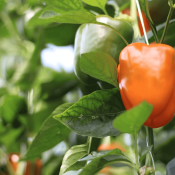Break the state of winter recess with the Chill Unit widget
Chill Units (CU) are generally used for fruit trees and flower bulbs. Fruit-bearing trees need a period of cold weather after which a fruit-bearing tree will blossom. Andreas Lypas, propagation manager at Castleton Fruit, explains how he uses chilling units to prepare for winter.
Chilling requirement is the number of effective chilling hours needed to restore bud growth potential in spring. Chilling refers to the requirement of low temperature to allow normal growth in the following spring. Not getting enough winter chilling results in a decline in both yield and fruit quality.
The chilling requirement is usually measured in terms of numbers of hours, during which temperature remains at or below 7°C during the colder months of the year. Getting enough winter chill makes sure that latent buds can break the state of winter recess and begin growing during the spring. Measuring chill units can make a huge difference in yield quality of blueberries, strawberries, raspberries, cherries and peaches.
You can use the Utah model to measure the chilling requirement. This model contains a weight function assigning different chilling efficiencies to different temperature ranges. It also weights negative contributions by high temperatures. The Utah model defines a chill unit as the permanence of the buds for a period of 1 hour in a temperature range considered optimum (2.5-12.5°C) to accumulate chill.
The Utah model is more complex because it introduces the concept of relative chilling effectiveness and negative chilling accumulation or chilling negation. According to research temperatures between 0°C and 16°C promote the breaking of rest whereas higher temperatures negate such effects.
Maximum promotion occurs at 7°C ( 1 hour at 7°C = 1 chill unit). Higher and lower temperatures within the range of 0 – 16°C are less effective.

The Utah Model can be used to measure the chilling requirement.
Unfortunately, that means that growers need to keep an Excel file and update it every day. That needs a lot of effort and labour time and cost. Luckily, I found the Growing Degree Units & Chill Hours widget in 30MHz’s platform.
I’m finding the widget extremely useful and I can still see the process in real time. With no extra effort, all the data appears in my dashboard. With these data, I can precisely analyse next year’s crop of soft fruits and stay focused on other job tasks. I can still evaluate the data and have a global perception of winter temperatures. After evaluating the low winter temperatures, I chose to grow the best suitable cherry variety. With a complete picture of the Growing Degree Hours, I achieved precision farming and optimised crop yields.

How Andreas Lypas is measuring Chill Hours in the 30MHz-platform.
What’s very helpful about 30MHz’s sensors and platform, is the accuracy of the data, the transport and the immediate traceability. The calculation of chill hours in the dashboard is done by counting the hours below a certain threshold, which the grower selects and has a graphic representation of evolution.
Helpful and insightful papers:


30MHz is typing… Our extended support team is ready to chat!
At 30MHz we think it’s important that our users can use our platform in an optimal way. At times you may have questions and you would like some help from our support team. Email and our support page filled with helpful articles were your go to’s. But we thought it was time for something extra… ...Read more
New 30MHz connect casing: How we protect your tech
To make sure your dataflow is fully protected, 30MHz introduces a new connect casing: waterproof, dust proof and even resistant to hits. This special shield will last longer and ensure a reliable dataflow from the connected sensor. What does that full protection mean? That’s what we will explain in this article. Watertight: resistant to wetness ...Read more
Smart assistant at work
After the launch of the smart (AI) assistant at GreenTech, the first growers have started using this new feature. The assistant helps them gain insights from their data faster and supports daily decision-making in the greenhouse. Growers report that they use the assistant for: Calculating differences in water content throughout the day Quickly identifying trends ...Read more


